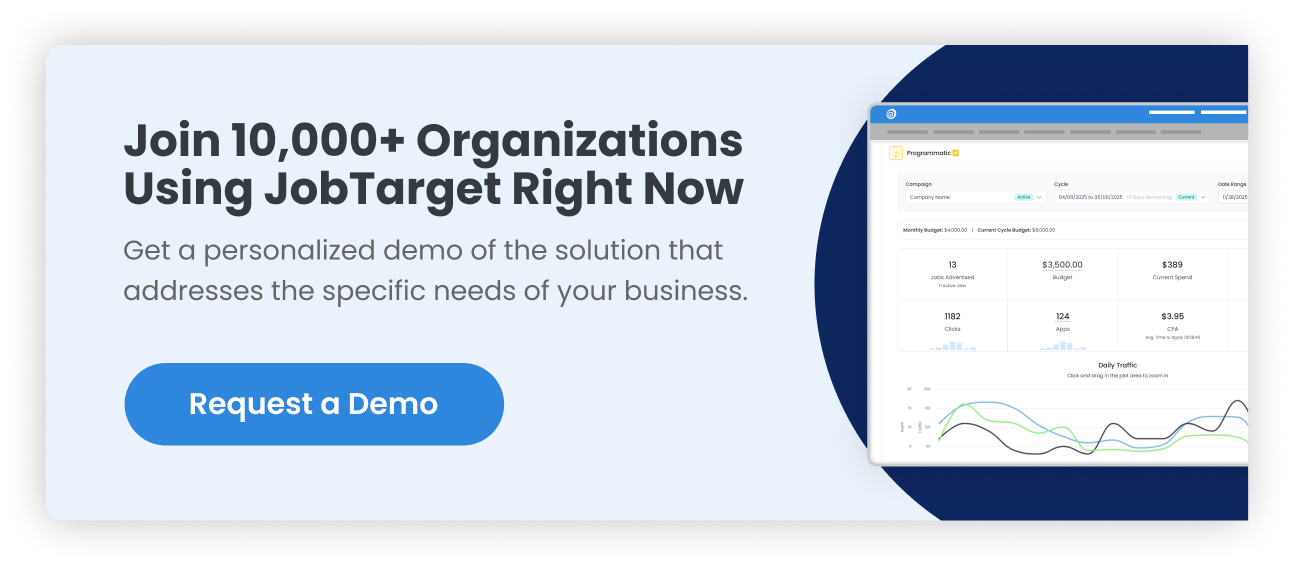Today’s hiring market is extremely competitive, and recruiters have had to pull out all the stops to find candidates and fill open roles.
There’s one method that has remained true, even in the midst of uncertainty. Leveraging data. Leveraging data is one way that recruiters can amplify and optimize their job advertising strategy for better, faster results.
But, now it’s time to get a little creative with your data. Geotargeting is one way that you can use data to expand your reach or optmize your ad spend. Geotargeting involves posting your ad to strategic locations. Various data points can be used to inform what those strategic locations might be.
Leveraging data
Access to data allows you to make informed, strategic decisions about how to advertise a job. When you approach job advertising strategically, you’ll be able to make the most of your ad spend, attract more of the qualified candidates you’re looking for, and, ultimately, make hires faster.
Job advertising data can be used to:
-
Understand how your ads perform compared to others
-
Improve the performance of your ads
-
Better optimize your ad spend
-
Operate in a competitive hiring market
Some types of data that you might find helpful in improving ad performance include:
-
Compensation averages and ranges
-
Job title clustering
-
Average hiring cycle
-
Location clustering
Geotargeting is one way of applying these types of data and insights in order to be more strategic in your advertising.
What does it mean to geotarget your job ads?
Geotargeting is a method of targeting advertising based on the geographic location of your audience. In traditional marketing, this tactic is typically used to target specific buyers in a specific area. Rather than spending a lot of money to advertise broadly, the advertiser is able to reach a local audience with a specific set of ads tailored to those buyers.
In job advertising, geotargeting can be used to get your job ads in front of a specific job seeker audience. You can make your recruitment budget go further but zeroing in on the markets where you’ll have the most success getting candidates to apply to your open role.
Benefits of geotargeting in job advertising
Geotargeting is a good tool to use if you want to make your recruiting budget go further, increase your applicant volume, or get in front of a specific audience.
Budget optimization
As a recruiter, two numbers you regularly keep an eye on are your recruiting budget and cost-per-hire. To keep these numbers down, you have to identify ways of optimizing your job ads so you get better results (more clicks, applies, and hires) without simply throwing more money at the problem.
One way to get the most out of your ad spend is with geotargeting. This allows you to focus your budget on the specific locations where you’re most likely to find candidates.
Increase applicant volume for rural positions
When you’re outside of a major city, it can feel like you’re working with a pretty small talent pool. Particularly if you’re hiring for more specialized roles or in rural areas, this might be a frustration you’re more than familiar with. Geotargeting can help ease these frustrations by helping you expand your pool of talent.
The first thing to do is to ask yourself if the position can be done remotely. This will drastically increase your audience and allow you to advertise your job in locations where you’re more likely to find the candidates you need. You can post your role in major cities, or in locations where specific talent clusters can be found.
If your job isn’t remote, consider expanding your search to nearby areas. Again, you can reference a talent cluster map to see where your nearest substantial pool of talent can be found.
Get in front of a specific audience
In addition to expanding your audience, geotargeting can also be used to narrow down your search to find clusters of candidates with a specific skill set or other requirements for your role.
For example, maybe you have a role that requires a fluent Spanish speaker. You can target your job ad to geographic locations that are likely to have higher concentrations of Spanish speakers.
Another example of where you could apply this approach is when looking to fill part-time or seasonal roles. You can target your job ads to locations around colleges and universities as students are most likely to be looking for more flexible schedules.
To learn more about geotargeting or other ways that you can find and apply job advertising data to make more strategic advertising decisions:
-
Read our Recruitment Advertising 101 Guide
-
Chat with a JobTarget representative today!


.png)





